Posted: October 11th, 2015 | No Comments »
Previously on Canton Drug Runners of 1939… Chung Lei is now in the custody of the SFPD and letters in his hand have revealed the plan to use a concession at the Golden Gate Expo in San Francisco as a front for opium dealing. His accomplice in smuggling the drugs has been revealed as neither an innocent party nor Chung’s wife, but in fact his mistress and mother of three of his children. The two remain in jail awaiting the judge’s final verdict….
On January 28th 1939 Judge Michael J. Roche presided over the trial of accused Canton drug “runners” Chung Lei and Leung Ying (or Yin) Lin (Leung Ting Lim in some papers who seemed to be having awful trouble getting her name right!), now referred to in the local papers as the “broke banker” and the “comely concubine”. He handed down five year sentences to both in federal prison for drug smuggling after which they were to be deported back to China. “Petite” Miss Leung broke down into tears as the judge pronounced.
Throughout the trial Miss Leung had had no counsel – she spoke through an interpreter and Chung Lei offered her no help with her defence. However, he had tried to protect himself in court. Chung was represented by James Whalen who could not muster much of a defence except that Chung was desperate after having his business in Canton destroyed by the Japanese invasion of China. While the Judge accepted that Chung was a victim of terrible circumstances due to the Japanese invasion of China it did not excuse his opium smuggling into the United States. Annoyed that Chung was trying to get a reduced sentence by claiming distress due to the war in China, Miss Leung told the court that their plan to import drugs into America under cover of the fireworks and candy concession at the Golden Gate International Expo was purely an attempt to pay off gambling debts and recoup Chung’s lost fortune. Chung’s attempted defence fell apart – he was in debt to criminal gangs and, in an attempt to extricate himself, had attempted to both smuggle opium into America and set up a sales operation at the Golden Gate Expo!
Chung it seems was indeed desperate – he now admitted that, on his earlier visit in July 1938, he had smuggled in a trunk of opium to Seattle when he had visited to secure the Golden Gate Expo concession. As mitigating circumstances he claimed that he had a wife and a further eight children back in Canton depending on him. The Judge was not impressed.
And so they were sent down….5 years each and then deportation…the Golden Gate Expo drug ring was shut down before it had managed to even start.
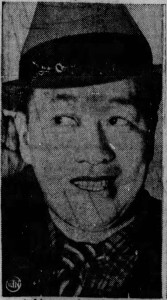
Chung Lei – the “broke banker of Canton”
Posted: October 10th, 2015 | No Comments »
Previously on Canton Drug Runners of 1939….the mysterious brocaded gown and fur coat adorned Miss Seto Gin sits in a San Francisco jail on a charge of importing 49 cans of raw opium to the United States; a man travelling with her, Chung Lei, has slipped through customs and is on the run in California. The SFPD, who suspect Chung of being the “kingpin” of a Canton drug cartel, have launched a massive manhunt to get Chung Lei back…
Chung stayed free for most of January 1939 before turning himself in to federal authorities on the 25th of the month. He had been lying low in a local lodging house in San Francisco. By that time a lot had happened. Mrs Seto Gin/Mrs Chung Lei was in the city jail but, it had been ascertained by contacting the British police in Hong Kong, she was actually a Miss Yeung Yin Lin, aka Violet Wong, 21, 22 or 24-years of age (the reports conflict though all are roughly a decade younger than originally reported!) of Hong Kong. Gin/Chung/Yeung/Wong, whoever she was really, and Chung Lei were now incarcerated at the San Francisco City Prison. The SFPD grilled them to uncover the cartel.
Slowly the story was pieced together and eventually told by U.S. Attorney Sydney P. Murman to a Federal Grand Jury. It was quite amazing….
Chung Lei and Violet Wong were both members of prominent Canton (Guangzhou) families. Chung had graduated from New York University, then worked as a high school principle in Canton before becoming the manager of a Canton bank. Violet Wong, though only 21 (or maybe 22 or maybe 24), had already borne him three children. But she was not his wife, despite declaring herself as such on the ship passenger records so as to share a cabin – Chung’s wife was still living in Canton. Wong was Chung’s “second wife” or, as the newspapers enjoyed reporting, his “concubine”.
The Japanese invasion of southern China in 1937/1938 had ruined Chung’s banking business and he had drifted down to British-controlled Hong Kong. However, he had been unable to re-establish himself there and had fallen on seriously hard times. He began gambling in Hong Kong and Macao and ended up owing rather a large debt to a local Canton gambling concern who ran casinos in both places and who’d lent heavily to him. They suggested he could work off the debt by smuggling drugs for them.
In July 1938 Chung had arrived on a still existing student visa in San Francisco to arrange to operate a concession at the upcoming San Francisco Golden Gate International Exposition to be held on Treasure Island. As well as providing fireworks Chung wanted to operate a booth selling lace and Oriental confectionery. Miss Wong was to be hired as a demonstrator at the booth. The real plan though was to use the concession to smuggle in opium in boxes of fireworks and tins of candies and then deal the drugs during the Expo. However, while in San Francisco, Chung ran out of money and wrote a letter to his criminal contacts back in Hong Kong. Copies of the letters were found in Wong’s luggage implicating him in the proposed drug dealing operation. Chung has used Violet Wong to smuggle opium to America as candies and fireworks, opium she was then to sell at the Expo – at the lodging house where Chung had been hiding out was found another trunk with a false bottom containing yet more opium.
The jury returned two counts of smuggling against the pair and bail was set at US$10,000.
Tomorrow – the final installment – The Verdict…
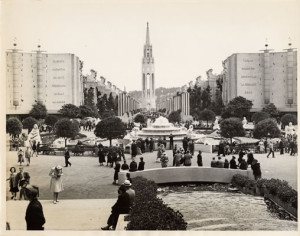
San Francisco’s Golden Gate International Expo, 1939
Posted: October 9th, 2015 | No Comments »
Following on from yesterday’s post on two Hong Kong drug mules arrested at San Francisco in 1939…
Mrs Seto Gin was originally arrested disembarking the President Coolidge from Hong Kong by Mr M.J. Jordan of the US Customs Service, a man who specialised in spotting drugs mules arriving from Far Eastern ports to America. Gin was transported to a jail cell and left overnight, but not before being fingerprinted by Matt Savasta, head of the San Francisco police check and bank detail.
The next day she appeared before U.S. Commissioner E.E. Williams where it was established that the “comely” Miss Gin was indeed Mrs Chung Lei. She further insisted that she was actually from Hong Kong and required an interpreter to translate. The U.S. Attorneys passed her case to the Federal Grand Jury and her bail was set at US$20,000. The defendant appeared in court still wearing the “lustrous brocaded Chinese gown” she was arrested in – but now with a “rich fur coat” too.
Gin was held incommunicado. The San Francisco Police stated that they believed she was a “runner” for a “huge drug syndicate” operating out of Shanghai and Hong Kong. In police custody Mrs Gin/Chung found time to redo her make-up in her hand mirror (see below).
Now the SFPD wanted Chung Lei, described as being 37-years-of-age. A man hunt was launched for him…and he was named as the Kingpin of the drug smuggling operation…
Tomorrow….the Hunt for Chung and the real plot revealed…
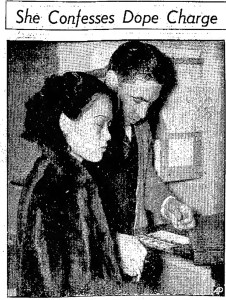
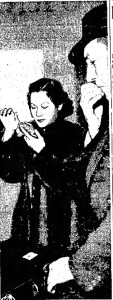
Posted: October 8th, 2015 | No Comments »
What possessed Mrs Seto Gin of Shanghai to become a drug mule in 1939? War, impoverishment, opportunity, blackmail, the chance to turn a quick buck and exit Japanese occupied Shanghai? We don’t know…but she did. In early January 1939 she was busted by U.S. Customs Agents as she stepped off the American President Lines ship the President Coolidge from Hong Kong….
In the middle to late 1930s criminal gangs in China, Hong Kong and Macao (Chinese and foreign) smuggled vast amounts of opium into America. Some went in large batches but most went in luggage – rotating Fourth Marines, showgirls heading back to America and Chinese making the crossing. Wealthy middle class Shanghainese were particularly popular with the gangs as they were not examined as closely as poorer Chinese arriving. But clearly being too glamorous also attracted the attentions of the customs men…
Here, from 1939, 32-year-old Mrs Seto Gin attracted some attention. She was busted, wearing a “lustrous Chinese gown”, “brocaded” and “slit to above the knee”, disembarking at San Francisco. She is described as “young” and “attractive” in one newspaper and “petite” and “Almond-eyed” in another. She is carrying a not inconsiderable 49 cans of opium (it was often repacked into cans claiming to contain Chinese confectionery) in, wait for it, a trunk with a false bottom – not an overly original stash spot, even in 1939. The stash was worth US$10,000 (another newspaper said US$100,000 – but that sounds a bit high for 49 5-tael cans in 1939 – valued at US$65 a tin – and I’ve seen the 10Gs reference elsewhere).
Customs quickly searched other arriving passengers but found that a Mr Chung Lei, a former Chinese bank president according to the ship’s passenger records (presumably fallen on hard times since the Japanese invasion) had already gone ashore and disappeared. As the only other passenger to have boarded in Hong Kong with Seto Gin the police announced that they would like to speak with him.
Tomorrow – The Trial…
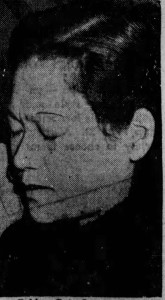 Seto Gin…busted
Seto Gin…busted
Posted: October 7th, 2015 | No Comments »
An online archive definitely worthy of a plug – a database of the Heidelberg Research Architecture (HRA) on Republican-era Chinese women’s magazines including Nüzi shijie (Women’s World, 1904-07), Funü shibao (The Women’s Eastern Times, 1911-17), Funü zazhi (The Ladies’ Journal, 1915-31), and Linglong (Elegance, 1931-37). Trust me – you’ll spend a good portion of your day searching through these old issues once you start!
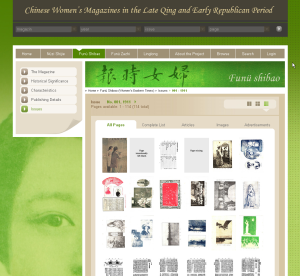
Posted: October 7th, 2015 | No Comments »
So it seems Hong Kong’s post boxes are to have their royal cyphers covered up to stop “confusion”! Not sure what the confusion was exactly – I’m pretty sure everyone in Hong Kong knows what a post box looks like and didn’t think they were just boxes to drop letters to the Queen into!! But Hong Kong Post thinks differently – or rather some bureaucrat in Beijing thinks they should think differently. The Hong Kong Conservancy Association is having a go at convincing Hong Kong Post otherwise but orders are orders it seems. More here.
The 59 old post boxes remaining in use in Hong Kong are of different ages, including seven with the royal cyphers GRV for King George V, two GRVI for King George VI, 49 with ERII for Queen Elizabeth II, and just one with a Crown of Scotland in Central, according to the website of HK Post-Box Search Team. After the handover, the previously red post-boxes, brought over from England, were painted green.
Several cities in China used to have some nice Republican era post boxes still in use – such as these in Dalian (that were there in 2009 at least)…but Hong Kong will apparently have to change….

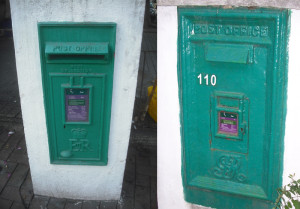
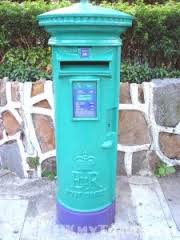
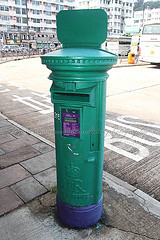
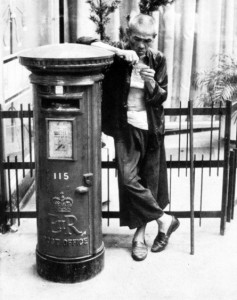
Posted: October 6th, 2015 | 1 Comment »
Meant to post this in September but forgot!! Anyway, September 1939 and all Germans living in Hong Kong were interned – put in a Catholic School and surrounded with barbed-wire. The school was La Salle College on Prince Edward Road in Kowloon run by the Christian Brothers (the current site is a later building – the original, as in 1939, is far grander and shown below). The fact that the internees preferred their two squares a day in internment to being shipped back to Hitler’s Fatherland may be a bit of Brit propaganda but maybe not – sunny Hong Kong was probably preferable to Germany.
Hong Kong went on full war alert – much as the UK with Air Raid Wardens, Fire Marshals, beefing up protections around the harbour against sneak attacks and dealing with the possibility of air attack. The final battle was of course not to come until after Pearl Harbor in December 1941 and was, of course, against the Japanese rather than the Germans….
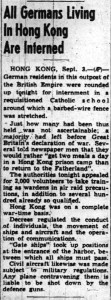

Posted: October 5th, 2015 | No Comments »
Daniel Jackson’s Famine, Sword and Fire deals with the American troops in Southwest China in WW2 – a group rather conspicuously absent from the recent Beijing 70th anniversary WW2 parade where apparently nobody fought with the Chinese!
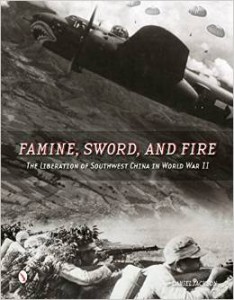
The untold story of Chinese and Americans standing side-by-side, fighting together and dying together on the highest, most rugged battlegrounds of WWII. In May 1942, the Japanese 15th Army conquered Burma and southwest China. Only a desperate defense by disorganized and defeated Chinese troops and the war-weary remains of Claire Chennault’s mercenary Flying Tigers stopped the advance at the Salween River. For two years, the people of southwest China lived under an oppressive Japanese occupation while Generalissimo Chiang Kai-shek, President Franklin Roosevelt, General Joseph Stilwell, and Major General Claire Chennault bickered over what to do next. Finally, in May 1944, the Chinese Expeditionary Force, with American supplies and advisors, supported from above by the legendary 14th Air Force, crossed the Salween to take back what they had lost.













